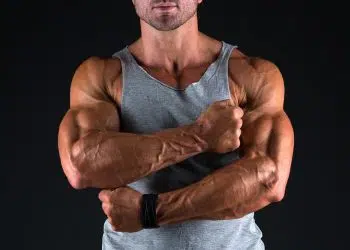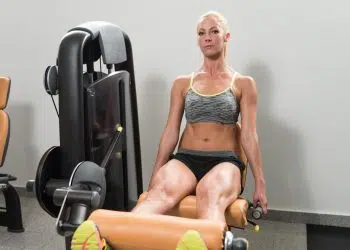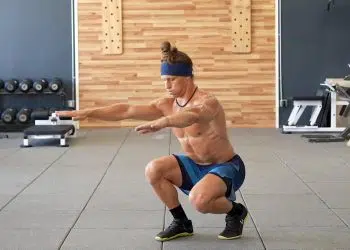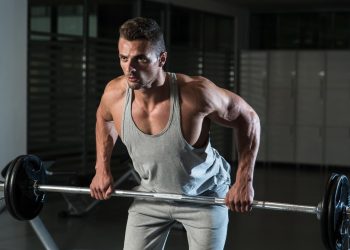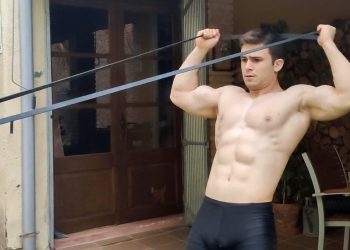Friends don’t let friends skip leg day, or at least that’s what the memes say.
And while many lifters spend plenty of time working on their quads, glutes, and hamstrings, the calves are often forgotten. Or, almost as bad, they get just a couple of sets of heel raises at the end of a leg workout.
It’s no wonder that so many people are unhappy with their calf development.
To build calves you can be proud of, you need to do a combination of seated and standing calf raises, giving your lower legs the same care and attention you lavish on your arms.
But what if you are bored of doing endless sets of seated calf raises or train at home and don’t have access to a seated calf raise machine? What do you do then?
The good news is that there are plenty of exercises that are just as effective as seated calf raises.
Level Up Your Fitness: Join our 💪 strong community in Fitness Volt Newsletter. Get daily inspiration, expert-backed workouts, nutrition tips, the latest in strength sports, and the support you need to reach your goals. Subscribe for free!
In this article, we reveal the best seated calf-raise alternatives and share some of our most potent calf-building tips!
Seated Calf Raises – Muscles Worked
To be considered a suitable alternative to seated calf raises, the exercise in question must train the same muscles. So, what muscles do seated calf raises work? Let’s take a look!
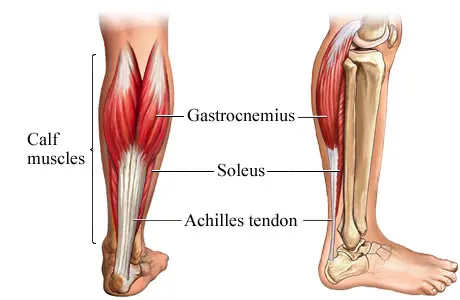
Gastrocnemius
The gastrocnemius is the dual-headed outermost calf muscle. The gastroc is a biaxial muscle, meaning it crosses two joints – the ankle and the knee. As such, it has two primary functions.
The first function of the gastrocnemius is plantar flexion of the ankle. This means pointing your toe, as happens during calf raises.
The second function of the gastrocnemius is knee flexion. It works with the hamstrings to help bend your knees. Watch your calves during leg curls to see them contract to aid your hamstrings. However, this is quite a weak action compared to plantar flexion.
Seated calf raises are performed with bent knees, which puts the gastrocnemius in a mechanically disadvantageous position. As such, while it IS involved in seated calf raises, it’s not the most active calf muscle during this exercise. That honor goes to the…
Soleus
The second calf muscle, the soleus, lies beneath the gastrocnemius, and only the lower section is visible. Unlike the gastroc, the soleus is a uniaxial muscle that only crosses one joint; the ankle. Somewhat surprisingly, the soleus is the biggest of the two calf muscles and also the strongest.
The soleus only has one function – plantarflexion.
While the soleus and gastrocnemius work together, it is possible to emphasize the soleus by working with bent knees. When your knees are bent, the gastrocnemius is put into a semi-relaxed position and cannot contribute as much to plantar flexion.
So, to summarize, seated calf raises work your calves (doh!), which comprise two muscles – the gastrocnemius and soleus. Both muscles are trained during seated calf raises, but the soleus is the most active of the two.
12 Best Seated Calf raise Alternatives
Whether you are bored of seated calf raises or don’t have access to a seated calf raise machine, these are the exercises you can do instead.
- Dumbbell or barbell seated calf raise
- Standing calf raise machine
- Dumbbell single-leg standing calf raise
- Donkey calf raise
- Leg press calf raise
- Jump rope
- Ankle hops
- Tiptoe farmer’s walk
- Squat hold calf raise
- Hill sprints
- Calf jumps
1. Dumbbell or Barbell seated calf raise
No seated calf raise machine? No problem! You can train your soleus and gastrocnemius using freeweights, an exercise bench, and a low step or bumper plates. This exercise is perfect for home lifters.
Steps:
- Sit on an exercise bench with your knees bent to 90 degrees. Rest the balls of your feet on a raised platform, such as a wooden plank, a bumper plate, or a low step.
- Next, rest and hold a barbell or dumbbells on your lower thighs, just above your knees.
- Extend your ankles and rise up onto your tiptoes. Then, lower your heels back down and get a good stretch in your calves.
- Continue for the prescribed number of repetitions.
Muscles targeted:
- Primary: Soleus.
- Secondary: Gastrocnemius.
Benefits:
- A low-tech high-effect exercise that’s ideal for home use.
- No special equipment required.
- An excellent replacement for machine seated calf raises.
Tips:
- Pause at the top of each rep to maximize muscle recruitment.
- Do this exercise barefoot to strengthen your feet as well as your calves.
- Place a folded gym mat or towel across your legs for comfort, especially if you plan on using heavy weights.
2. Standing calf raise machine
Contrary to what many people think, seated calf raises don’t only work your soleus, and standing calf raises don’t only work your gastrocnemius. Both exercises train both calf muscles, even if seated calf raises do emphasize the soleus. So, you don’t have to do seated calf raises if you don’t want to, and you may be able to build big lower legs doing nothing but standing calf raises.
Steps:
- Place the balls of your feet on the footrest, so your heels are free to move up and down. Place your shoulders under the pads and stand up. Brace your core and straighten your legs. Grip the handles firmly.
- Lower your heels down toward to floor to get a good calf stretch.
- Next, push up onto your tip toes like you are trying to sneak a peek over a high fence.
- Lower your heels and repeat.
Muscles targeted:
- Primary: Gastrocnemius and soleus.
- Secondary: N/A.
Benefits:
- A very accessible exercise as most gyms have a standing calf raise machine.
- Highly scalable – you can go as light or as heavy as you wish.
- Standing calf raises are easy to learn and ideal for beginners.
Tips:
- Lower your heels slowly and then lift the weight explosively to maximize calf muscle engagement.
- You can also do this exercise using a Smith machine and step or bumper plates for a footrest.
- Do standing calf raises with just one leg to identify and fix any left-to-right strength imbalances and improve your mind-muscle connection.
3. Dumbbell single-leg standing calf raise
Seated and standing calf raise machines aren’t the only option for lower leg training. In fact, you can get a great calf workout with a single dumbbell and a step. This is an excellent exercise because you’ll need to work harder to stabilize your ankle, which increases calf muscle engagement.
Steps:
- Stand on the edge of a step on one leg. Cross your other foot behind your ankle. Hold a dumbbell on the same side and use your free hand for balance.
- Lower your heel down toward the floor to get a good stretch in your working calf.
- Rise up onto your tiptoes, pause, and repeat.
Muscles targeted:
- Primary: Gastrocnemius, soleus.
- Secondary: N/A.
Benefits:
- A perfect calf exercise for home lifters.
- No special equipment required.
- You can do this exercise without weight if necessary.
Tips:
- Use a lifting strap if training with heavy weights, so your grip doesn’t fail before your calves.
- Try a 10-1 descending pyramid to burn out your calves in record time. Do ten reps on your left leg and then ten on your right. Immediately do nine reps on your left leg and nine reps on your right. Without resting, go back and forth doing one less rep per set until you end with one rep.
- Pause at the top and the bottom of each rep to increase time under tension and get a more intense calf workout.
4. Donkey calf raise
The donkey calf raise is an old-school lower leg exercise. While there are donkey calf raise machines, this exercise is traditionally done with a partner sitting across your hips. Needless to say, depending on the strength of your calves, you should choose your donkey calf-raise partner carefully and based on their weight.
Steps:
- Bend over from your hips and place your hands on a bench for support. Rest your toes on a wooden plank, low step, or bumper plates. Brace your abs and make sure your lower back is slightly arched.
- Get your partner to sit astride your hips.
- With your partner in place, rise up onto your tiptoes and then lower your heels down to get a good stretch in your calves.
- Lift and lower your heels for the prescribed number of reps.
Muscles targeted:
- Primary: Gastrocnemius, soleus.
- Secondary: N/A.
Benefits:
- No special equipment required.
- Provides a unique muscle-building workout for your calves.
- An excellent exercise for more experienced lifters.
Tips:
- Turn your feet in to target the outer head of the gastrocnemius or out to target the inner head.
- Bend your knees slightly to take tension off your hamstrings and increase soleus engagement.
- You can also do this exercise using a chin/dip belt across your hips instead of a partner, like this:
5. Leg press calf raise
You don’t need to use a standing calf raise machine to train your lower legs when you’ve got a leg press. Leg press calf raises feel a lot like donkey calf raises, but you don’t need a partner to do them.
Steps:
- Get onto the calf raise machine and press the weight carriage up. Then, carefully position the balls of your feet on the edge of the footplate. Your legs should be straight but not locked.
- Flex your ankles and lower your toes toward your shins.
- Points your toes away and repeat.
- On completion of your set, bend your legs and lower the weight carriage back down.
Muscles targeted:
- Primary: Gastrocnemius, soleus.
- Secondary: N/A.
Benefits:
- A very accessible exercise as most gyms have a leg press machine.
- A good alternative for donkey calf raises.
- You can do this exercise with as little or as much weight as you want, so it’s ideal for beginner, intermediate, and advanced lifters.
Tips:
- Don’t place the balls of your feet too near the edge of the footplate, as a slip could cause a serious accident.
- Add a small thrust with your knees to help you complete the last couple of reps of your set. This is a training method called cheat reps.
6. Jump rope
Jumping rope is a cardio conditioning and fat loss exercise that can also help you build bigger, more powerful calves. Do a few sets of jump rope daily to see your calves become cows!
Steps:
- Hold an end of your jump rope in each hand. Stand with the middle of the rope on the floor behind you.
- Flick your wrists, so the rope passes over your head. Jump over it as it approaches your feet.
- Keep going for the prescribed duration or number of jumps.
Muscles targeted:
- Primary: gastrocnemius, soleus.
- Secondary: Quadriceps, deltoids, heart, lungs.
Benefits:
- Burn calories and get fit as you develop your calves.
- Good for improving agility and coordination.
- A good exercise for warming up your claves before your main leg workout.
Tips:
- Stay on your toes to maximize calf engagement.
- Use your ankles more than your knees to ensure your calves do most of the work.
- Experiment with different jump rope styles (high knees, double-unders, Ali shuffles, etc.) to hit your calves from various angles.
8. Ankle hops
If you can’t jump rope, this exercise is a viable alternative. It works in much the same way, but you don’t need to be a proficient rope jumper to do it. Try doing a set of ankle hops after calf raises to really pump up your lower legs.
Steps:
- Stand with an upright torso and brace your core. Take a narrow stance with your feet no more than one foot apart. Get into position by slightly bending at your knees.
- Explosively hop off the floor.
- Land on your toes with your knees slightly bent.
- Immediately transition into another hop and repeat.
Muscles targeted:
- Primary: Gastrocnemius, soleus.
- Secondary: Quadriceps.
Benefits:
- No equipment required, so an ideal exercise for home workouts.
- An excellent exercise for athletes.
- Preferentially targets the type 2 muscle fibers, which are responsible for muscle strength and size.
Tips:
- End your set when you feel you cannot jump as high.
- Jump forward, backward, and side to side to hit different parts of your calves.
- Do this exercise on a forgiving surface, e.g., a gym mat, sprung wooden floor, grass, or AstroTurf.
9. Tiptoe farmer’s walk
We’re the first to admit this exercise looks pretty weird, but it’s so brutally effective that it’s worth the funny looks you’ll get at the gym when you do it. It’s also a very straightforward exercise that you can perform to failure, and all you need to do it is a pair of hefty dumbbells.
Steps:
- Hold a dumbbell in each hand, arms by your sides. Pull your shoulders down and back, and brace your abs.
- Rise onto your tiptoes and, without lowering your heels, take a walk around your training area.
- Continue until you are unable to keep your heels up.
Muscles targeted:
- Primary: Gastrocnemius, soleus.
- Secondary: Quadriceps, core, trapezius, forearms, glutes.
Benefits:
- An excellent exercise for calf size and ankle joint stability.
- Provides a unique training stimulus for the calves.
- Builds an unbreakable grip as well as beefing up your lower legs.
Tips:
- Take short steps to make the most of a small training area.
- Wear lifting straps if your grip starts to fail before your calves.
- Carry one weight to create more instability and increase core activation. Remember to swap sides set by set.
10. Squat hold calf raise
Do you want to train your entire lower body, including your calves, in one brutally effective exercise? Then this is the movement you’ve been waiting for! While it may not be the best mass builder, it’s a great finisher for your leg workouts.
Level Up Your Fitness: Join our 💪 strong community in Fitness Volt Newsletter. Get daily inspiration, expert-backed workouts, nutrition tips, the latest in strength sports, and the support you need to reach your goals. Subscribe for free!
Steps:
- Stand with your feet slightly wider than shoulder-width apart, toes turned outward.
- Descend into a deep squat and extend your arms out in front of you for balance.
- Without standing up, rise onto your tiptoes and then return your heels to the floor.
- Continue for the prescribed number of reps.
Muscles targeted:
- Primary: Soleus.
- Secondary: Gastrocnemius, quadriceps, hamstrings, gluteus maximus.
Benefits:
- Good for developing lower body mobility as you work on your calves.
- No equipment required, so an ideal calf exercise for home workouts.
- An excellent exercise for high-rep calf training and chasing the pump.
Tips:
- Hold on to a support if you find it hard to maintain your balance.
- Lift one heel at a time for variation.
- Adjust the depth of your squat based on your hip mobility.
11. Hill sprints
Hill sprints are a surprisingly calf-centric exercise. Running as fast as possible up a steep hill requires a lot of muscle power, and the incline means you must move your ankles through a large range of motion. In short, hill sprints are an unconventional but effective way to build bigger calves.
Steps:
- Find a steep hill and mark out a 20-30 yard stretch for your workout.
- Run up to your start line and then accelerate up the hill, i.e., a rolling start. Pump your arms, drive your knees up, and your feet back. Lean into the incline.
- At the top, slow down to a walk and then return to the bottom of the hill.
- Rest a moment and repeat.
Muscles targeted:
- Primary: Gastrocnemius, soleus.
- Secondary: Hamstrings, gluteus maximus, quadriceps, cardiovascular system.
Benefits:
- A very functional lower body exercise that’s perfect for athletes.
- Good for fitness and fat burning, as well as developing bigger calves.
- No equipment required, so ideal for home exercisers.
Tips:
- Warm up with some light jogging and calf stretches before doing this strenuous exercise.
- No hills nearby? Get a similar workout by sprinting up flights of stairs.
- Wear a weight vest or a backpack to make this exercise more demanding.
12. Calf jumps
Some of the most well-developed calves belong to athletes who never do any direct calf work. This strongly suggests that power exercises may help build bigger calves, so include box jumps, sprints, and other plyometric exercises in your calf workouts.
Then, add this simple plyometric calf exercise to your leg workouts a couple of times a week to unlock new calf growth.
Steps:
- Load up the calf raise machine with a heavy load. Get into position with your shoulders under the pads and toes on the edge of the footrest.
- Lower your heels slowly down toward the floor. Get a good stretch.
- Bend your knees and then explosively jump up into your tiptoes.
- Lower slowly again and repeat.
Muscles targeted:
- Primary: Gastrocnemius, soleus.
- Secondary: Quadriceps, gluteus maximus, hamstrings, core.
Benefits:
- Preferentially targets the type 2 muscle fibers responsible for size and strength.
- An excellent exercise for athletes.
- Provides a unique training stimulus – expect to be sore for days after doing this exercise!
Tips:
- This exercise works best when done for low to medium reps with moderate to heavy weights.
- Do this exercise with a Smith machine if preferred.
- You can also do this exercise on a leg press machine like this:
Calf Training Tips
Are you struggling to build stellar calves? Use these tips to take the brakes off your calf development.
1. Use a full range of motion for each and every rep
Rise up as high as you can onto your tiptoes, and then lower your heels down as far as your flexibility allows. This increases time under tension and muscle activation, which are both crucial elements for maximal muscle growth.
2. Use a slow, controlled tempo
Most calf raise variations are more productive if you avoid using momentum to lift the weight. Take two seconds to rise up and two seconds to lower back down. Of course, this is not the case for exercises like ankle hops or calf jumps, which should be performed explosively.
3. End your sets with partial reps
Full-range reps should make up the bulk of your calf training, but partial reps are helpful for getting a big pump and finishing off any untapped muscle fibers.
Do your set as usual, and then, on reaching failure, pulse up and down an inch or two in the middle of your normal range of motion. Use this intensifying method on the last set of each exercise only.
4. Try turning your feet in and out to target different parts of your calves
Turning your feet in may increase outer calf development, while turning your feet out may increase inner calf development. Use this technique on standing calf raises, seated calf raises, and other exercises listed in this article, including ankle hops and jump rope.
5. Work your calves every time you train
To shock your calves into growing, try training them every time you hit the gym. Do 2-4 sets of standing calf raises at the start of every workout and 2-4 sets of seated calf raises at the end. Do this every time you work out, even on upper body days.
For more information on training stubborn calves, check out this in-depth guide.
Frequently Asked Questions
Got a question about seated calf raise alternatives? Or about calf raise training in general? Don’t worry – we’ve got the answers!
1. How often should I train my calves?
That’s a tricky question to answer, as some old-school bodybuilders only trained their calves once a week, while others, like Arnold, used to train them six times a week! However, it’s a safe bet that two workouts per week will work well for most exercisers, and if your calves aren’t growing, training more often may help.
So, if you are currently working your lower legs twice a week and you aren’t getting the results you want, add another workout.
2. How many reps and sets should I do for my calves?
It’s generally accepted that muscles grow best when you train them to failure in the 6-35 rep range. However, as high reps can be time-consuming, you’ll probably do best if you stick to 6-20 reps for most of your calf training.
In terms of sets, try to accumulate 10-20 hard sets of calf training per week. This can be done in one long calf workout or several shorter sessions, depending on how often you like to train your calves.
3. Can I train my calves in bare feet?
Yes! A lot of old-school bodybuilders used to train their calves in bare feet. They believed that, with no shoes to support their feet, their calves had to work harder. But before you whip off your shoes and start doing calf raises, check with your gym that they are okay with barefoot training. Some may have issues regarding hygiene or health and safety.
4. Is calf size and shape genetic?
Genetics play a role in the size and shape of every muscle – not just your calves. If you train hard, eat right, and your calves still aren’t growing, your genetics could be the problem. That’s why some bodybuilders resort to calf implants. However, no matter your genetics, you can still make your calves bigger if you work hard enough.
5. How big should my calves be?
According to some old-school bodybuilders, your calves, arms, and neck should all be roughly the same size. So if your biceps measure 17″, your calves and neck should too. While you might not be able to achieve this standard exactly, it’s a good target for most people.
6. Do I have to do seated calf raises?
Standing calf raises work your gastrocnemius and soleus pretty equally. In contrast, seated calf raises put more stress on the soleus. As standing calf raises hit both lower leg muscles, you may be able to develop muscular calves without seated calf raises.
But, if you want your lower calves to pop, and remember that the soleus is actually the biggest of the two calf muscles, you may still benefit from including seated calf raises in your leg workouts.
More Alternative Exercises:
- Donkey Calf Raises Alternatives for Massively Muscular Lower Legs
- Best Calf Raise Machine Alternatives for Bigger, Stronger Lower Legs
- Best Sissy Squat Alternatives for Bigger, Stronger Quads
- Best Barbell Squat Alternatives
- Home Squat Alternatives for Strong, Sculpted Legs
- Smith Machine Squat Alternatives for Powerful, Muscular Legs
Wrapping Up
Seated calf raises are one of the best ways to target your soleus, which is the biggest of your two calf muscles. Paired with standing calf raises, these two exercises can help you build impressive lower legs.
However, in the same way you wouldn’t limit yourself two just two biceps, chest, or triceps exercises, there is no need to train your calves with just these movements.
Use the 12 seated calf raise alternatives in this article to add some much-needed variation to your leg workouts and build calves you can be truly proud of!
Interested in measuring your progress? Check out our strength standards for Smith Machine Squat, Seated Calf Raise, Donkey Calf Raise, and more.


